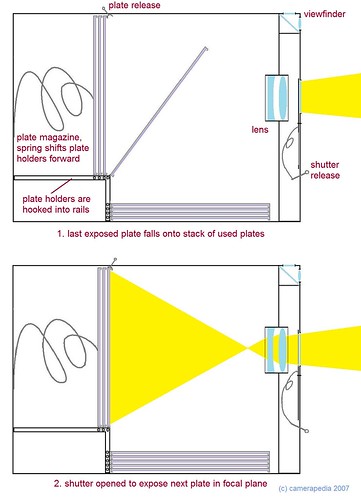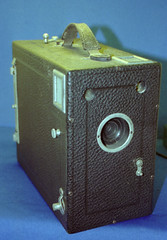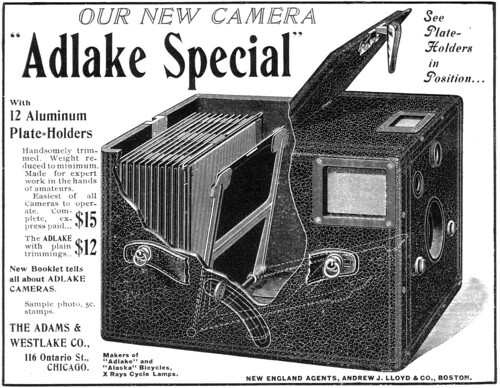(→Links) |
m (→Links) |
||
| Line 44: | Line 44: | ||
*[http://licm.org.uk/livingImage/Midg.html Butcher's Midg of 1905] at Living Image Museum [http://licm.org.uk] |
*[http://licm.org.uk/livingImage/Midg.html Butcher's Midg of 1905] at Living Image Museum [http://licm.org.uk] |
||
*[http://www.boxcameras.com/no2magcycl.html Western Camera Mfg. Co.'s Cyclone camera] at BoxCameras.com [http://www.boxcameras.com] |
*[http://www.boxcameras.com/no2magcycl.html Western Camera Mfg. Co.'s Cyclone camera] at BoxCameras.com [http://www.boxcameras.com] |
||
| − | *[http://www.antiquewoodcameras.com/bullard.htm The |
+ | *[http://www.antiquewoodcameras.com/bullard.htm The Bullard Folding Magazine Camera, Series B, ca. 1898] at Antique Wood Cameras [http://www.antiquewoodcameras.com] |
[[Category:Magazine camera]] |
[[Category:Magazine camera]] |
||
Revision as of 23:03, 14 November 2007
The two main types of magazine cameras
In the 1890s a new type of camera became popular: The magazine camera. This type of large box camera allowed to make a series of 8 to 12 exposures on medium or large format glass plates or film sheets without reloading. That was quite convenient by means of more or less helpful mechanical plate changing facilities. The camera mechanicians developed a great variety of easy plate change mechanisms. The cameras were loaded with a set of tin plate holders or tin film sheet holders. Of course each holder had to be loaded with a film sheet or a sensitized glass plate before. The term "falling plate camera" stands for a quite exciting subtype of these cameras: The holders of used plates fell face down onto a stack on the camera bottom, or an unused plate fell from the stack below the camera top into focal plane position before exposure. Therefore the plate holders were hooked into rails so that they ever moved and fell into the right place. These magazine cameras had to be loaded in the dark chamber or in a dark tent.
Another type of magazine camera was loadable in daylight. It had to be loaded with a set of light proof covered plate holders or sheet holders. Some of these cameras had a facility to open and to close the hinged front cover of the plate holder in focal plane. After closing its front cover the holder with the exposed plate was simply drawn out and shifted back into the magazine at the end of the stack so that the next plate holder was shifted into the focal plane. The most renowned maker of such magazine cameras was the train-lantern and camera maker Adams & Westlake.
The typical magazine camera is equipped with two built-in reflecting type viewfinders, one as waist-level finder for vertical format shots, the other as waist-level finder for horizontal format shots. That's like the finder equipment of most box cameras, but most magazine camera finders have larger screens (or ocular lenses). Many of these cameras were even equipped with a mechanical exposure counter. In spite of the missing abilitiy of exact ground glass focusing some of the magazine cameras were even outfitted with superb lens types. Around the turn from the 19th to the 20th century these cameras were popular, but they were invented much earlier. It was John Benjamin Dancer from Manchester who got the first patent on a magazine camera in 1856.
Pictures of the falling plate type
| loading a "falling plate camera" | cross section showing how it works |

|

|

|

|
| unknown maker, ca. 1910 | |
| Houghtons 1912 magazine camera with superb Bausch & Lomb lens: | |

|
Pictures of the daylight loading type
Adams & Westlake's popular versatile Adlake Special
|
| An old ad shows the H-shaped plate holder cover opening lever inside the camera: |

|
Links
- Butcher's Midg of 1905 at Living Image Museum [1]
- Western Camera Mfg. Co.'s Cyclone camera at BoxCameras.com [2]
- The Bullard Folding Magazine Camera, Series B, ca. 1898 at Antique Wood Cameras [3]